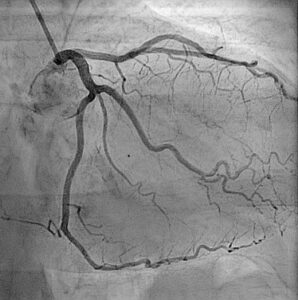
Introduction-
Hey Friends, I am Dr Ashish Agrawal practicing as an Interventional Cardiologist In Mulund West of Mumbai Suburb. Today we will discuss something that sounds like a dramatic love story: Broken Heart Syndrome.
Now, you might think it’s just a metaphor for sadness, but it’s a real, tangible medical condition. Picture this: someone goes through a massive shock or loss, and suddenly, they’re in the hospital with heart symptoms that mimic a heart attack.
It’s not fiction; it’s the reality of Broken Heart Syndrome, a condition that shows just how closely our emotions are tied to our heart health. Let’s unpack this intriguing syndrome and understand how our hearts react to the rollercoaster of life.

Understanding Broken Heart Syndrome-
Broken Heart Syndrome, or what doctors like to call stress cardiomyopathy, is fascinating yet complex. It’s most commonly known as Takotsubo cardiomyopathy, named after a Japanese octopus trap because the heart takes on a similar shape during an attack. Imagine your heart suddenly weakening in response to intense stress or emotion. It’s not just a one-off thing; it can happen again, which we call recurrent Takotsubo.
The most common form is apical ballooning syndrome, where the heart’s bottom ( Ventricle) balloons out, disrupting its normal pumping function. It’s like your heart is taking the brunt of emotional pain, swelling in places, trying to cope. This condition powerfully illustrates the heart’s sensitivity to emotional and physical stress. It’s more than just an organ pumping blood; it’s reactive to how we feel and experience life.
How common is broken heart syndrome?
As per the Cleveland Clinic around 2% of individuals suspected of having a heart attack experience Broken Heart Syndrome. However, the actual number might be higher, as the condition often goes unrecognized by healthcare providers.
Takotsubo cardiomyopathy predominantly impacts individuals assigned female at birth (AFAB), who account for approximately 89% of the cases, particularly post-menopausal (average age range between 58 to 77 years).
It’s thought that estrogen, a hormone, guards the heart against the stress-induced hormonal surge. With age, as estrogen levels drop, those AFAB may become more vulnerable to the heart-straining effects of abrupt emotional stress. It’s not as rare as winning the lottery, but it’s uncommon enough to be misunderstood.
Exploring the Types of Broken Heart Syndrome-
Diving into Broken Heart Syndrome, we find it’s not all the same. There are variations, each with its quirks.

First, we have the Apical type, the classic form. It’s like the heart takes a deep sigh, ballooning at the bottom. It’s the most common, capturing the essence of the syndrome.

Then there’s the Mid-ventricular type. Here, the heart’s Centre bulges, not the bottom. It’s as if the heart is swelling mid-way, trying to cope with stress.
Basal is another twist, where the bottom stays normal, but the top balloons. Imagine the heart wearing a cap that’s too big; that’s Basal for you.
Lastly, Focal, the rarest, where just a small part balloons out. It’s like a tiny bubble in one area, not affecting the whole heart.
Each type shows how versatile yet vulnerable the heart can be under stress. It’s a spectrum of responses to emotional turmoil, showcasing the heart’s intricate nature.
Recognizing the Symptoms of Broken Heart Syndrome–

Spotting the symptoms of Broken Heart Syndrome is crucial, as they mimic a heart attack. Think chest pain, that gripping, unbearable discomfort.

Then there’s shortness of breath like you’ve just run a marathon without moving an inch. These signs are your body’s alarms, screaming for attention.
Don’t brush them off as just stress or anxiety. They demand immediate medical help. It’s like smelling smoke in your house; you wouldn’t wait around, right? Acting fast is key.
Your heart’s sending an SOS; it’s time to listen and act. Because when it comes to your heart, it’s better to be safe than sorry.
Unveiling the Causes of Broken Heart Syndrome-

Broken Heart Syndrome can spring from different stressors. Emotional ones are like deep cuts to the heart. Think of devastating news, like losing a loved one, or intense fear from a near-miss accident. These moments can shock your heart into this syndrome.

On the flip side, physical stressors are more like brute force. Severe pain, rapid loss of fluids, or major surgery can push your heart into overdrive.
Both types of stressors yank hard on the heart’s strings, challenging its rhythm and function. It’s a stark reminder of how closely our hearts are tied to our life’s stresses and strains.
Distinguishing Between Broken Heart Syndrome and Heart Attack-
Broken Heart Syndrome and heart attacks might seem like twins at first glance, given their similar symptoms. However, they’re more like distant cousins under the surface. While both can bring on chest pain and breathlessness, Broken Heart Syndrome is typically triggered by intense emotional or physical stress, not by blockages in the arteries like a heart attack.
Imagine Broken Heart Syndrome as a temporary heart frenzy, stirred up by stress, whereas a heart attack is more like a long-term consequence of heart plumbing issues. Understanding this difference is crucial, as it steers the direction of treatment and highlights the heart’s sensitivity to our emotional and physical well-being.
Risk Factors of Broken Heart Syndrome: Who is at Risk?

Who’s in the hot seat for Broken Heart Syndrome?
It’s more common in women, especially those past menopause. But it doesn’t play favourites; younger folks and men can also be in the firing line, especially if they’ve faced sudden, extreme stress.
Think of it like a storm hitting the most unexpected places. Those with a history of neurological conditions or psychiatric disorders might find themselves more vulnerable, too. It’s like having a door that’s already slightly open, making it easier for the syndrome to push its way in. Knowing these risk factors helps us guard the door better and protect our hearts.
Diagnosing Broken Heart Syndrome-

Diagnosing Broken Heart Syndrome starts with peeling back the layers to see what’s beneath.
An Electrocardiogram (ECG) is often the first step, giving a snapshot of your heart’s electrical activity, and spotting any irregularities.

Next might be an Echocardiogram, using sound waves to create a heart image. It’s like looking inside, seeing how the heart pumps and if it’s shaped like that tell-tale Takotsubo pot. Blood tests also play a role, in checking for heart damage markers.

Sometimes, a Coronary Angiogram is needed, where dye is injected to highlight blood flow and blockages in arteries, ensuring nothing else is amiss.
Each test adds a piece to the puzzle, helping to confirm if Broken Heart Syndrome is the culprit behind your symptoms. It’s like detective work, with each clue bringing us closer to the truth of what your heart is experiencing.
Medications Used in Treatment-

Medications are like a team of healers in treating Broken Heart Syndrome, each with a special role.
ACE inhibitors or ARBs help relax blood vessels, easing the heart’s workload, much like loosening a tight belt for comfort.
Beta-blockers slow the heartbeat, giving your heart a much-needed break, like a quiet rest after a stressful day. Diuretics, the water pills, help reduce fluid buildup, preventing the heart from getting overwhelmed, like clearing out a flooded room.
And if blood clots are a concern, blood thinners step in, ensuring blood flows smoothly, like a stream unhindered by debris. Each medication plays its part in helping the heart recover and regain its strength.
When Medications Aren’t Enough: Exploring Surgical Options-

Sometimes, medications alone can’t fully mend Broken Heart Syndrome, and that’s when surgery might come into play. It’s like when a patch won’t fix a leak, and you need to replace a piece of the pipe.
In rare cases, if there are severe complications or ongoing heart issues, surgical options like inserting a stent to keep arteries open, or even bypass surgery, might be considered.
These procedures act as reinforcements, helping to secure and support the heart’s structure and function, ensuring it continues to pump effectively and keep you moving.
It’s all about giving your heart the backup it needs to heal and thrive.
Conclusion-
Wrapping up, Broken Heart Syndrome is more than just a metaphor for emotional pain; it’s a real, physical condition that echoes the deep connection between our emotions and heart health, like a storm that hits unexpectedly but can be weathered with the right preparation and response.
This syndrome is manageable with prompt recognition, appropriate treatment, and a heart-friendly lifestyle.
Remember, it’s crucial to listen to your heart literally and figuratively. Take care of it, heed its warnings, and seek help when needed. Your heart is your life’s drumbeat; let’s keep the rhythm healthy and strong.
